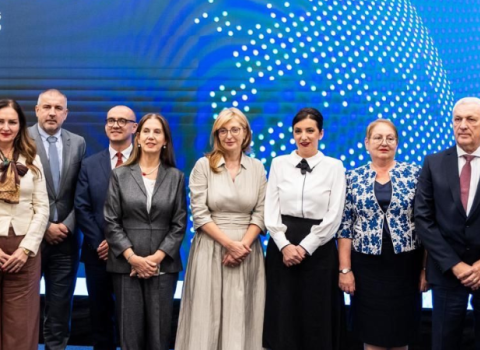After a slow start, the new instrument allowing partners in Widening countries to join a project after it starts is beginning to have an impact – but reservations remain about the way the scheme is being run

The hop-on facility allowing partners in Widening countries to join research consortia after they get off the ground is starting to have an impact, with 66 active projects, but participants tell Science|Business there are still some teething issues.
Hop-on adds another dimension to Widening measures which were designed to help countries that are lagging in research and innovation to catch up with better performing states. It enables a research consortium funded under pillar 2 of Horizon Europe or the EIC Pathfinder to add a partner from a Widening country after the project has begun, as long as there is not already a member from a Widening country.
It was designed to overcome the problem that researchers and research institutions in lagging countries are often left out of international consortia due to a lack of contacts or networks.
And it is having an effect. Science|Business spoke to people involved in two separate projects that have used the hop-on facility and both reported positive initial results, even if the relationship between the added Widening partner and the established consortium is still in the early stages.
After a slow beginning in which only six projects were funded during the first call, the measure is gaining in popularity. The second call led to 60 more projects being funded and the cut-off for the latest call that closed in September this year had 87 proposals.
Practical problems remain
But not everyone is satisfied with the measure. Tadas Tumėnas, head of the Lithuanian RDI Liaison Office in Brussels (LINO) said, “I like the theory behind this measure, but the practice of how it actually works, that’s the question. It doesn’t work smoothly as was planned.”
To find a consortium to join, partners in Widening countries search a list of projects that are eligible to have a hop-on partner on the European Commission’s funding and tenders portal.
The problem is, the coordinators of projects are not necessarily aware they are on that list, meaning they can receive a message seemingly out of the blue with a request to hop on.
In addition, the list is not always up to date. Some projects are nearing the end, other projects could already be in contact with another Widening partner, or projects could have no intention of including a new partner.
Aside from these shortcomings, another problem is that Widening partners struggle to contact coordinators of consortia they are interested in joining. On the tenders portal there is only an anonymous contact button to get in touch with a coordinator, and sometimes messages have ended up in coordinators’ spam folders.
In other instances, Widening partners have sent out a lot of requests without getting a response.
No Lithuanian partner has managed to hop on to a project yet. “Our [Horizon Europe national contact point] was promoting this a lot but at some point she said, ‘I can’t do this anymore because people come back disappointed’,” Tumėnas said.
He wants better communication from the Commission so that the coordinators of projects on the list are aware that is the case. Another approach would be to involve Horizon Europe national contact points in the process. If they had access to the list of eligible projects, they could help in the matchmaking process, potentially helping to reduce the number of requests that lead nowhere.
Hop-on evaluation survey
The European Research Executive Agency (REA), responsible for managing Horizon Europe grants, is conducting an evaluation survey of the hop-on facility.
Preliminary feedback from the survey shows that in around 50% of the successfully funded hop-on proposals, the Widening partner only needed to send one email to a consortium coordinator to get the process going.
This is both good and bad – depending on if you see the glass as half full or half empty. “It’s a bit like a lottery, if you get a lucky number it’s great, you win,” Tumėnas said. But some Widening partners had to invest far more than one email in finding a project to hop onto.
Varvara Mouchtouri, associate professor of hygiene and epidemiology at the University of Thessaly in Greece, is part of a team that recently hopped on to HIGH Horizons, a project looking at the effects of climate change on pregnant and postpartum women, children and health workers.
She said the experience has been great so far. “This cooperation has already given us opportunities to be involved in other projects, and to learn from other projects, and even to participate in the future in other proposals,” she said.
The impact goes beyond her team at the university too. “It’s also good for the country,” she said. “We have very few experts in our country that have done previous work on this topic.”
What’s in it for consortia?
The HIGH Horizons project has used the addition of Mouchtouri and her team to expand the scope of the project, both in terms of the target of the research, and geographically, allowing them to get data from Greece, a country greatly affected by climate change.
This is one of the main three reasons that consortia are using the hop on, according to the REA survey. The other two reasons are to add complementary expertise in an area they lacked, or to bring in new talent to give the project fresh perspective.
For Christian Stevens, senior full professor at the faculty of bioscience engineering at Ghent University, the hop on has a further advantage of bringing in extra funding.
He is the coordinator of the TransPharm project, which has recently had the Latvian Institute of Organic Synthesis (LIOS) hop on as an additional partner. He is happy with LIOS’ involvement and says they fit in nicely with the project.
“I was sceptical at first [about using the hop on],” he said, citing fears over additional administrative processes. In the end, he agreed as it meant extra money for the project. “If we didn’t add another partner it would be fine, but there was an opportunity to do it so we decided to go for it. It gave us some more flexibility in management as it meant more money, so that made it easier.”
The hop on comes with its own budget of €80 million for 2023 and 2024 with the expectation of funding around 160 projects. The Commission estimates a cost of between €100,000 - €600,000 for each successful hop on. The majority of that money must be spent exclusively for the benefit of the new partner, but 10% can go to increasing the overall budget of the project. This means there is a small financial incentive for consortia to hop on a partner.
One fear voiced by some member states when the hop on instrument was being drawn up was that consortia would deliberately exclude a Widening partner and then let them hop on after to get more budget. This does not appear to have happened in reality.
Despite some lingering scepticism, for those who have successfully hopped on to projects, it appears to be doing what it set out to do – exposing Widening partners to new contacts and projects.
“I expect the hop on will give our Latvian partners some more mobility,” Stevens said, saying that he is expecting people from LIOS to come to Belgium to learn more about the project.
Whether it will be possible to iron out some of the teething problems with the practicalities is another question and it could be too early to tell what the future of the hop on is. The REA survey, which does not yet have a publication date, will provide more insights for the Commission, which will continue to evaluate the effectiveness of Widening measures as Horizon Europe progresses.





 A unique international forum for public research organisations and companies to connect their external engagement with strategic interests around their R&D system.
A unique international forum for public research organisations and companies to connect their external engagement with strategic interests around their R&D system.